
Meteors, Milky Way, and Pareidolia on My Recent Grand Canyon Raft Adventure
I spent August 6-12 on a raft trip through Grand Canyon. Answers in Genesis and Canyon Ministries cosponsor several such excursions each year. This was my ninth time on this seven-day trip. As you might expect, there is a heavy emphasis on flood geology on these adventures. However, my annual trip is a little different – it’s billed as “Geology by Day and Astronomy by Night,” to which I’ve added the unofficial subtitle “If I Can Keep People Awake.” You see, after a long day on the river, most people are too tired to stay up very late.
Still, I get some takers. I generally start out by pointing out the brighter stars and notable constellations. I’m so glad that we now have bright green lasers to do this; it used to be difficult to direct people’s attention to the right places in the sky before these lasers were available. The summer Milky Way is a delight to look at. I usually pass a pair of my special astronomy binoculars around for people to scan the many nebulae and star clusters found along the Milky Way. I also bring along Johnson Observatory’s 3.5-inch Questar telescope to view any planets that are out. Fitting in the overhead bins of commercial aircraft, the Questar travels well, and it’s about the largest telescope I’d dare take on the river trips. The optional tripod is a different story – I tote in a tripod case that I must check on airplanes. On my travels, people ask me if the case is for golf clubs. I usually tell them yes, and that there is a long, par 500 golf course at the bottom of Grand Canyon (the water hazards are murder). I also tell them that I hope to break 900 this trip.
Speaking of planets, over the years that I’ve been doing this trip, we’ve had Jupiter and Saturn in the evening skies during summer months. However, as those two planets ponderously orbit the sun, they are slipping into autumn evening skies. Next year’s trip is in June, so people won’t be able to see either planet unless they get up early in the morning, as I usually do. It’s difficult enough for people to stay up a little late. It’s nearly impossible for most people to get up that early.
I prefer June trips because the weather then tends to be more reliably clear – the monsoon season starts around the beginning of July, so the skies in Arizona in July and August can be cloudy. However, there is another very important constraint – the moon. We never do the astronomy Grand Canyon raft trips during bright moon, when the moon is near full, because the moon’s light washes out the light of stars. We may as well be in a major city than to be in an otherwise dark site during bright moon. So, I much prefer risking cloudy nights during dark moon than to be in Grand Canyon during bright moon. Like this year, last year’s trip was in early August. One advantage of early August is that it coincides with the Perseid meteor shower. This year, the shower peaked on the morning of August 12, the day we left the river. Alas, the last two nights of our trip were cloudy. But the Perseid meteor shower lasts for about two weeks, so everyone on the trip saw at least a few meteors. Some people on this trip told me that they had never seen a meteor before, so I’m sure that was a special treat for them.
I’ve gotten into astrophotography in recent years. For meteor trails, I generally use a wide-angle lens on my digital SLR camera. For several years I’ve used my Nikon D3200 camera, but just before this year’s trip, I upgraded to a Nikon D5600. One feature on this camera allows me to program taking numerous photos, which saves me the trouble of manually taking each photo. Plus, I can go to sleep while the camera slaves on. I brought both cameras, with the newer one packed away during the day reserved for nighttime use and the older camera in my waterproof day bag for daytime use. When I take numerous nighttime photos, I can put them into a time-lapse video that shows the motion of stars. On this trip, all my nighttime photos were 20-second exposures with ISO = 6400.
Daytime Photos

First, let me share a few photos from the daytime. The other leader on this trip was Adam Huff.
Some of you may recognize Adam as the former Director of Operations at the Creation Museum. He also was a deacon at our local congregation, Cornerstone Baptist Church. About three years ago, Adam left Answers in Genesis and northern Kentucky to work for Canyon Ministries in Flagstaff, Arizona. Besides leading raft trips, Adam also does rim tours and hiking/camping trips in Grand Canyon for Canyon Ministries. This was the first raft trip we had done together, and it went very well. I hope that we do more such tours.
On the last full day of the trip, we stopped at National Canyon for lunch and a hike. While walking around at our lunch site, I spotted this fossil of a sponge in a boulder of Redwall Limestone lying on the beach.
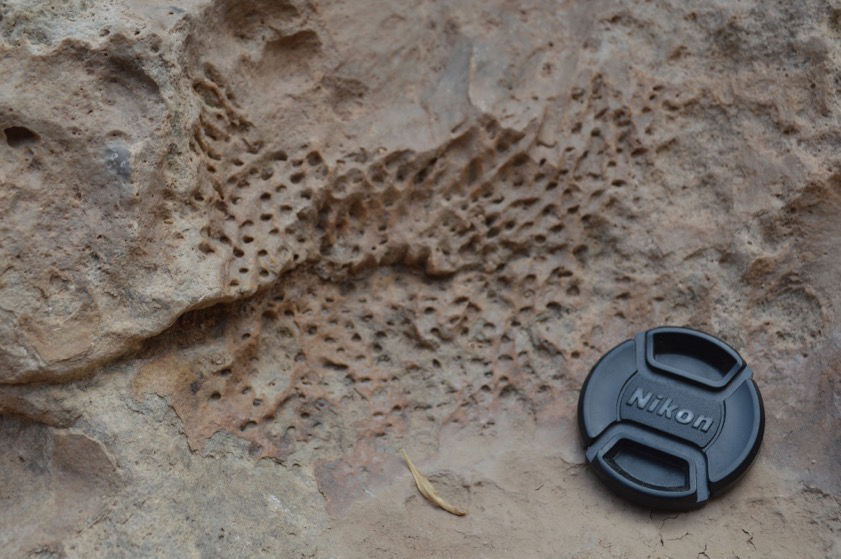
The Redwall Limestone is my favorite rock layer in Grand Canyon. It also is the favorite of Nate Loper, Canyon Ministry’s Director. A few years ago, Nate and I formed a very exclusive society for fans of the Redwall Limestone: The Royal Order of the Redwall. I decided to sit on another piece of the Redwall Limestone to eat my lunch and enjoy the view of the Redwall Limestone high on the cliffs above. What better way to celebrate this moment than by drinking a can of Cheerwine with my lunch? I’ve started the practice of shipping a few cases of Cheerwine to Nate shortly before my raft trips so that we can enjoy a few on the river, as well as introduce this obsession of mine to others.
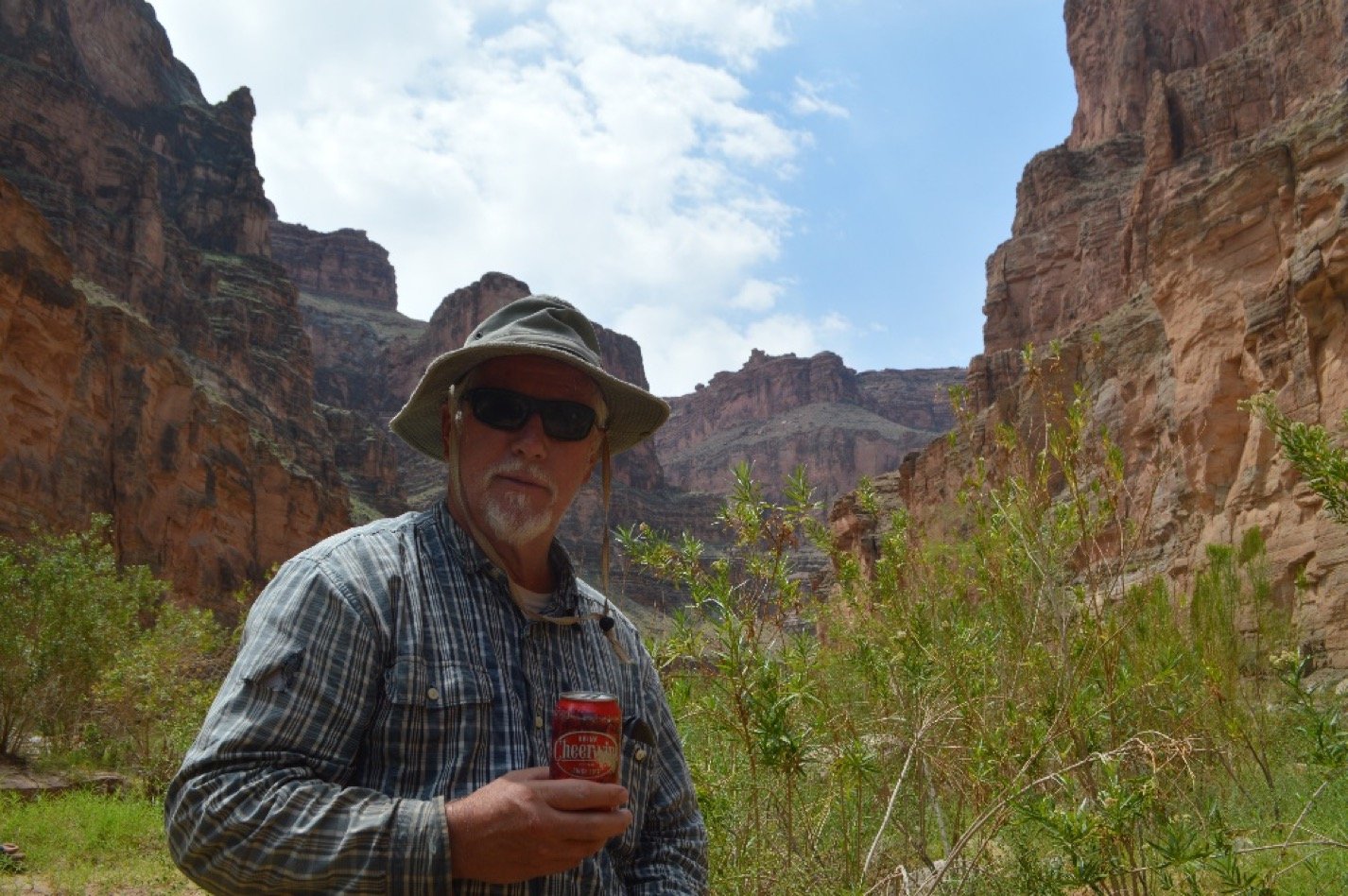
But there is more. Notice the rock sticking up above the rim of the Inner Gorge to the right of my hat. Proper cropping and expanding the photograph reveals that it has the shape of a small bird sitting on a nest. It is easy for me to see this with the naked eye, but the scale is much too small to make out in most photographs. I always look for this little gem on the next-to-last day on the river.
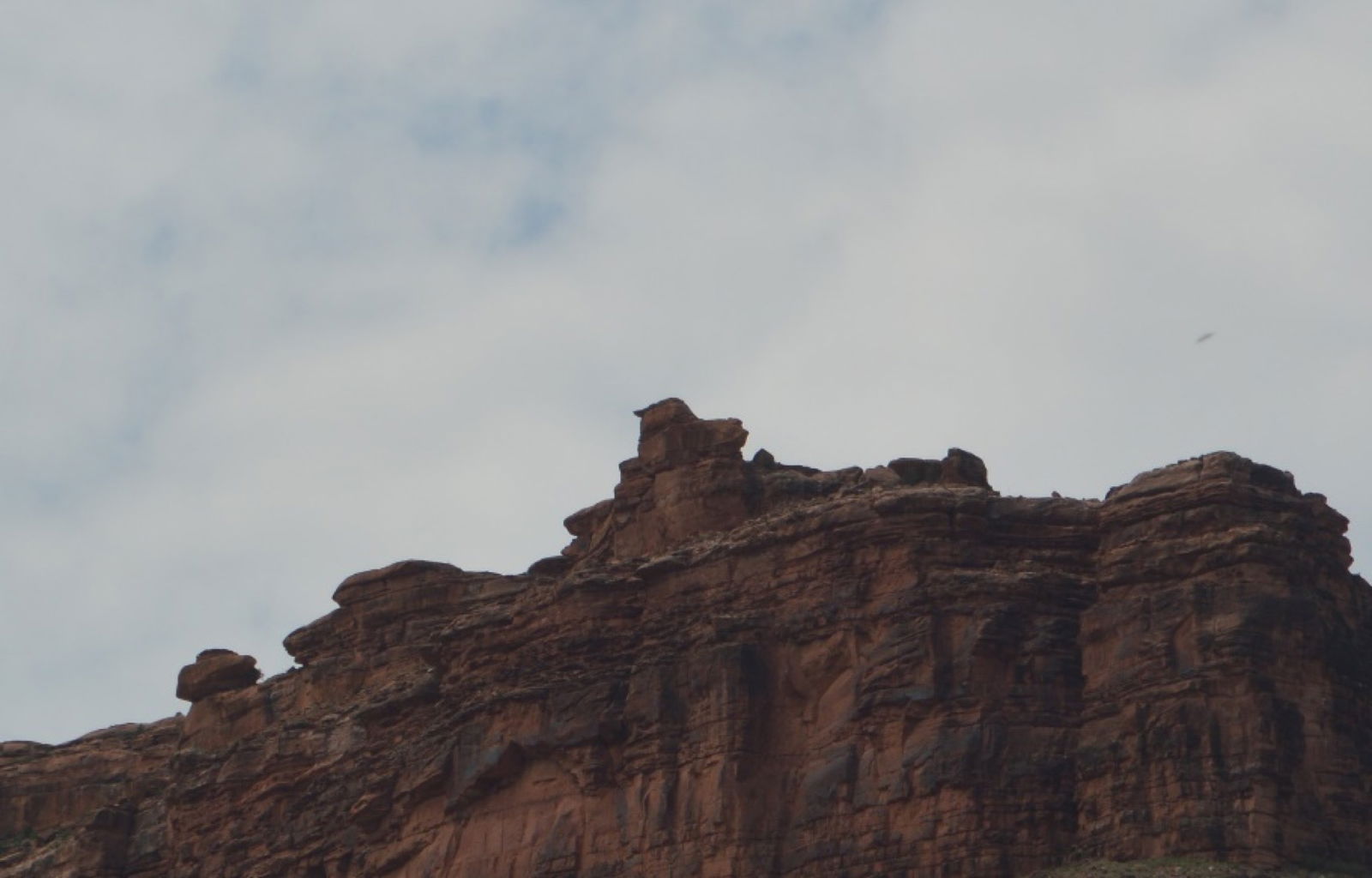
There are other examples of pareidolia (the tendency to perceive a specific image in an otherwise ambiguous visual pattern) in Grand Canyon rocks. For instance, look at the photo of Adam and me, taken while looking downriver from our campsite the night before, just below Deer Creek Falls. Notice that on the far left of the large sunlit part of the canyon wall, there are three to four rocks sticking up. When cropped and expanded, you can see that they look like a chicken pulling a train.
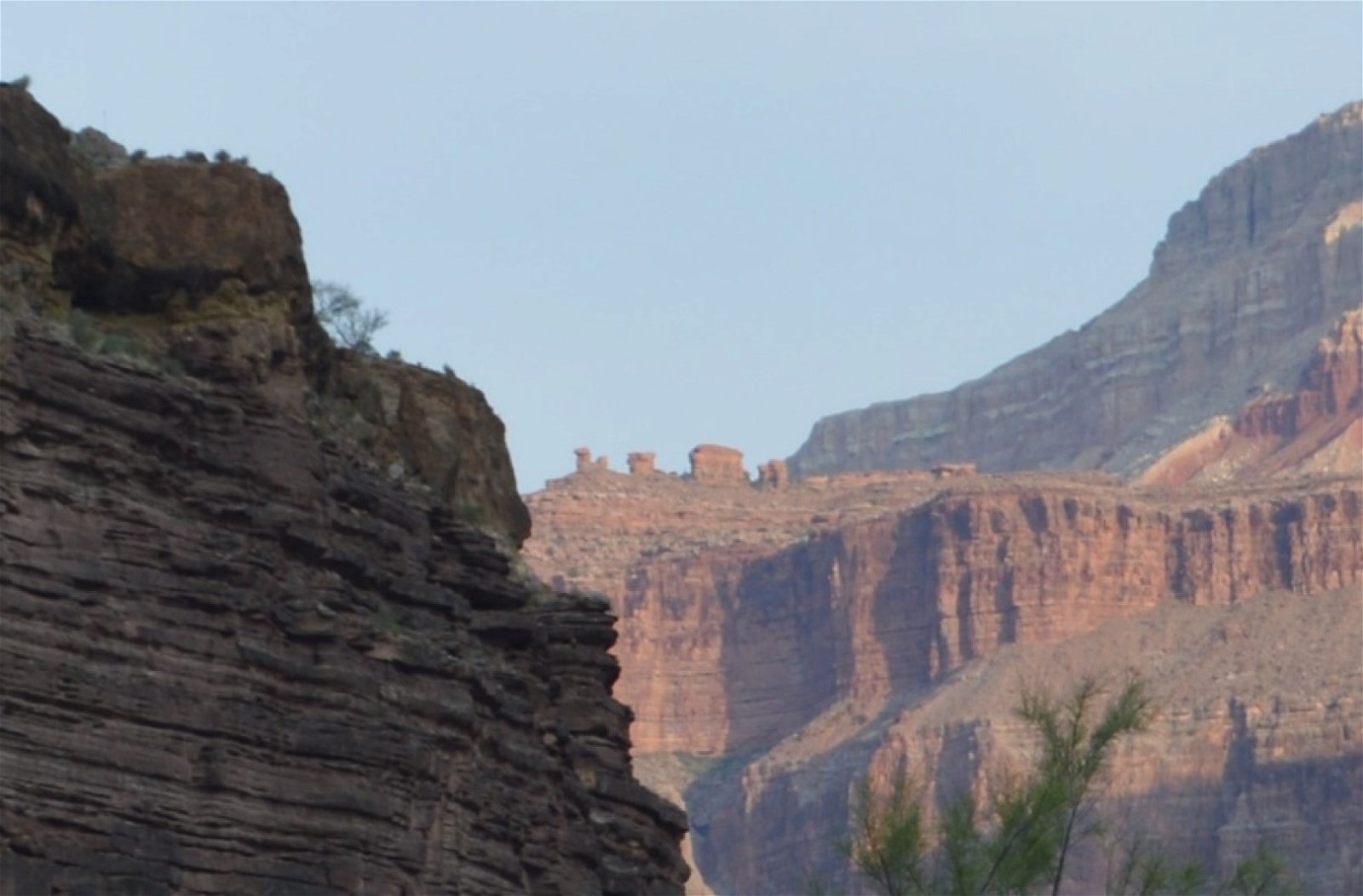
It briefly rained around dinner time at this campsite the night before. As it was still raining, the sun poked out when low in the west (near the chicken). That illuminated the sky back toward the east, upstream from our location, producing this wonderful rainbow.

You can make out a little of the secondary rainbow to the left of the rainbow. Besides their beauty, I appreciate the physics that makes rainbows possible. A few years ago, I came to realize that too often my thoughts ended there. Since then, whenever I see a rainbow, I dwell on the rainbow as being a sign of the Nohaic covenant, that God will never again destroy the earth with water (Genesis 9:8-17).
Meteors
I looked through each of my 1,200+ photos for meteor trails. There were far more trails from aircraft. Early evening and early morning photographs also had trails of satellites. How can I tell these from meteor trails? Some aircraft have colored, flashing lights, so those are easy. Other aircraft and satellite trails are relatively constant in their light, but meteors tend to change brightness across their paths. Unless aircraft and satellite trails appear in narrow notches of the canyon walls, they will appear on more than one photograph. However, because meteors are visible only very briefly (a second or less, as compared to the 20 seconds exposure of each photo), meteors will appear on only one photograph. I managed to identify 21 photographs with unambiguous meteor trails. There probably are a few faint meteors that I missed. This first photograph has two meteor trails.
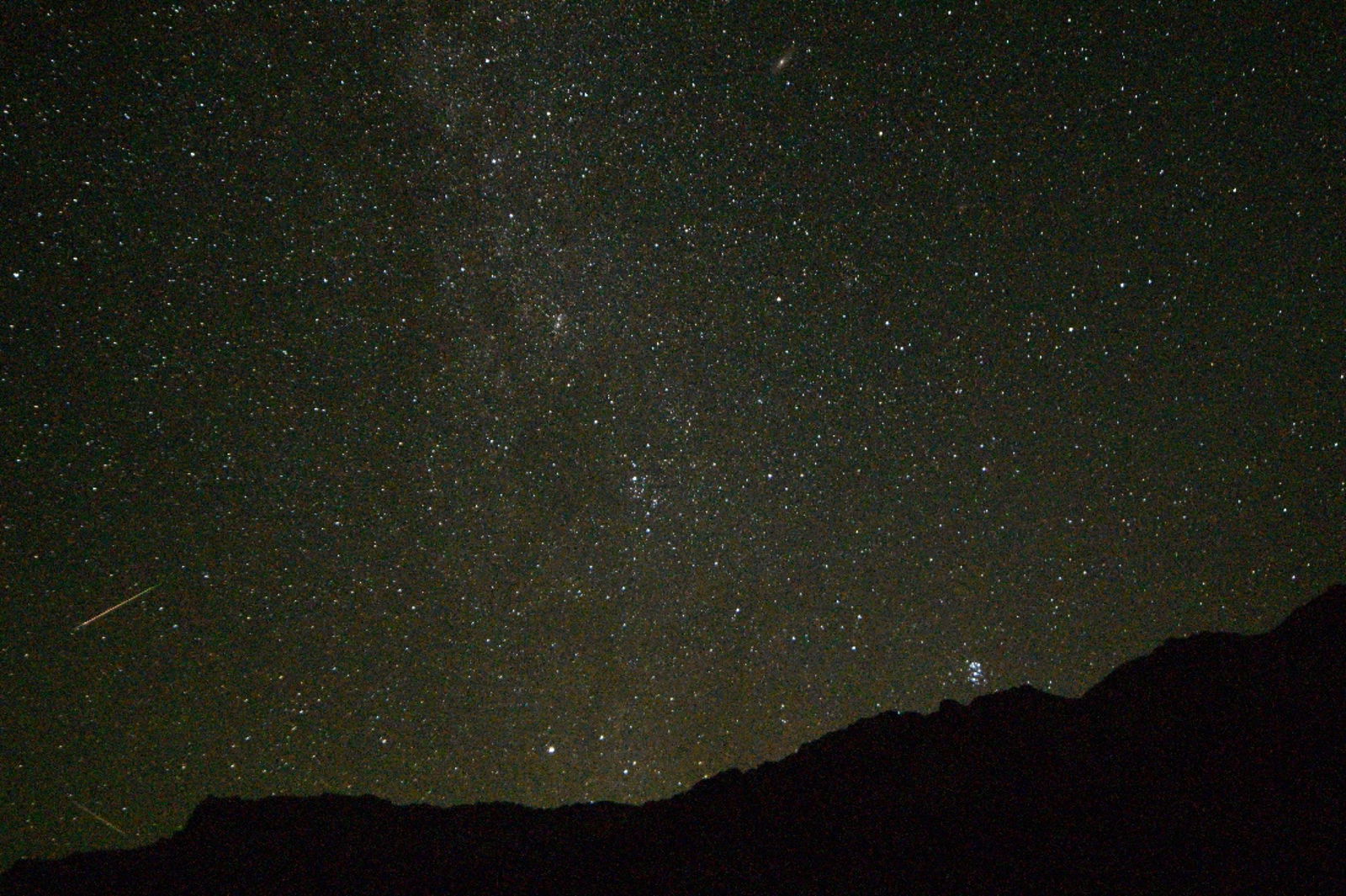
I have another photograph with two meteor trails.
The second photograph has the longest meteor trail. Notice how the meteor changed colors throughout its path. This is common with brighter meteors.
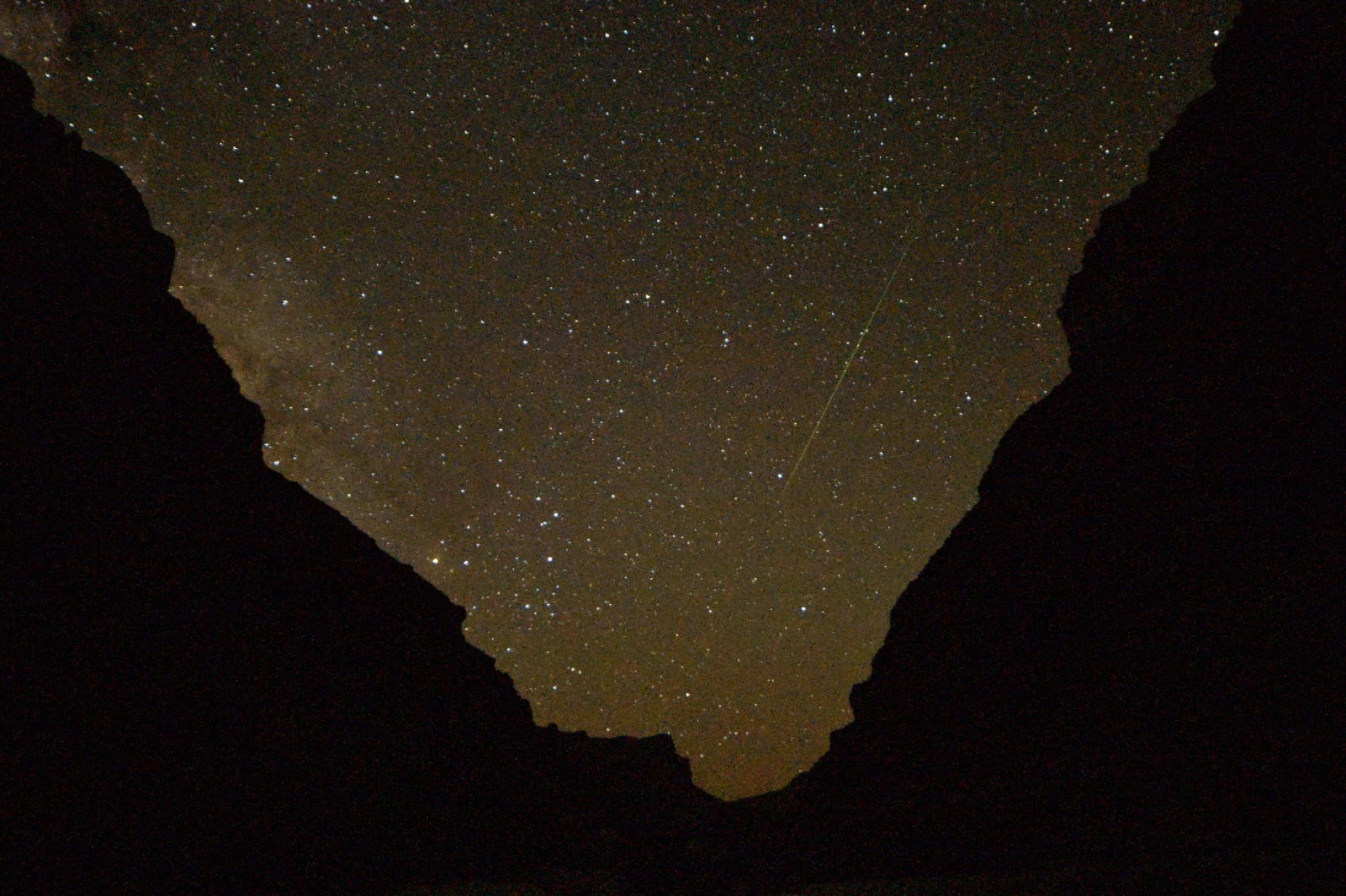
The third photograph has the brightest meteor I recorded.
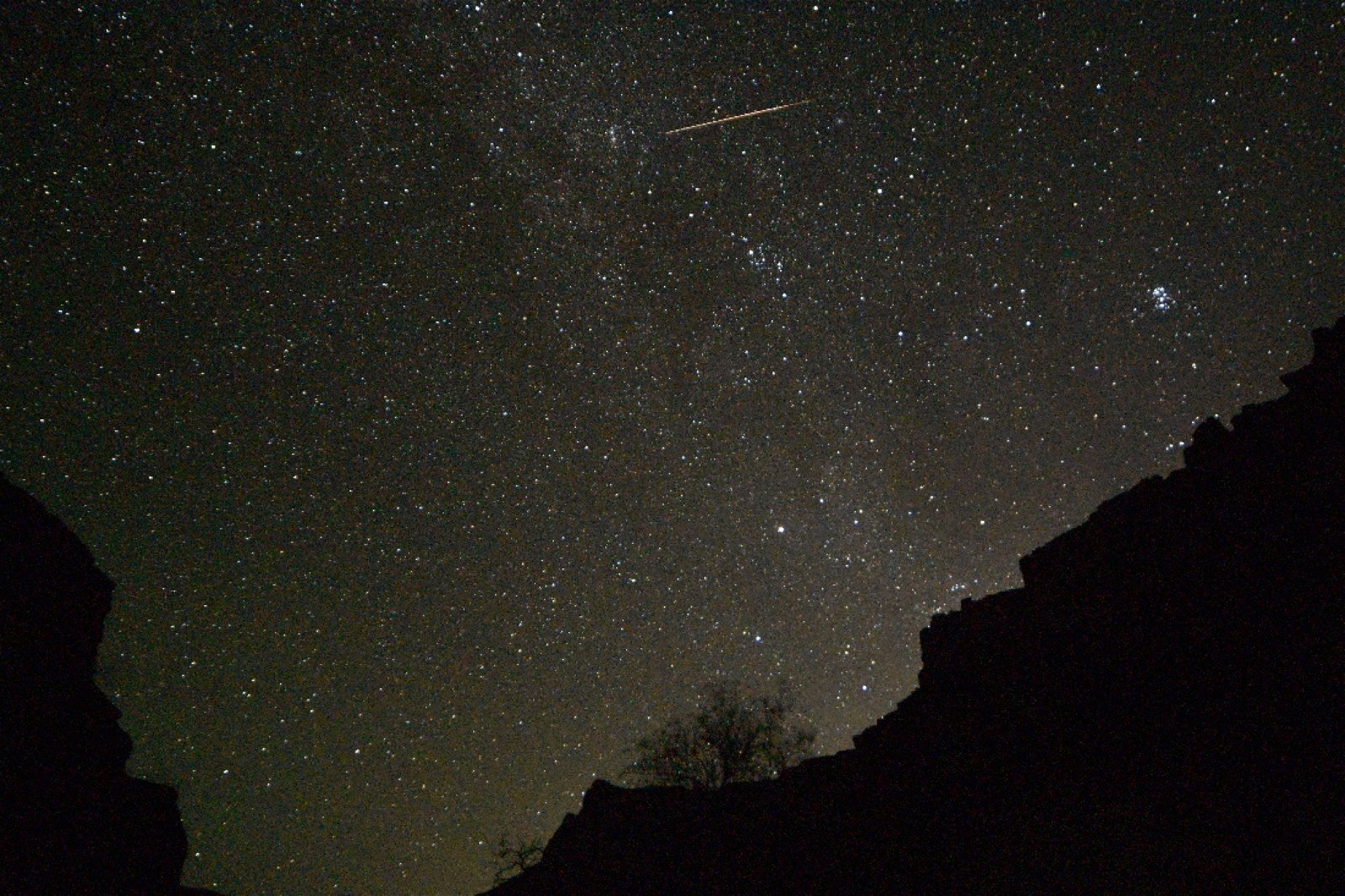
The final photograph shows a bright, short meteor trail. It too changed color along its path. The Andromeda Galaxy, M31, can be seen to the upper right of center. It looks like a fuzzy star that is slightly elongated toward the lower left and upper right.
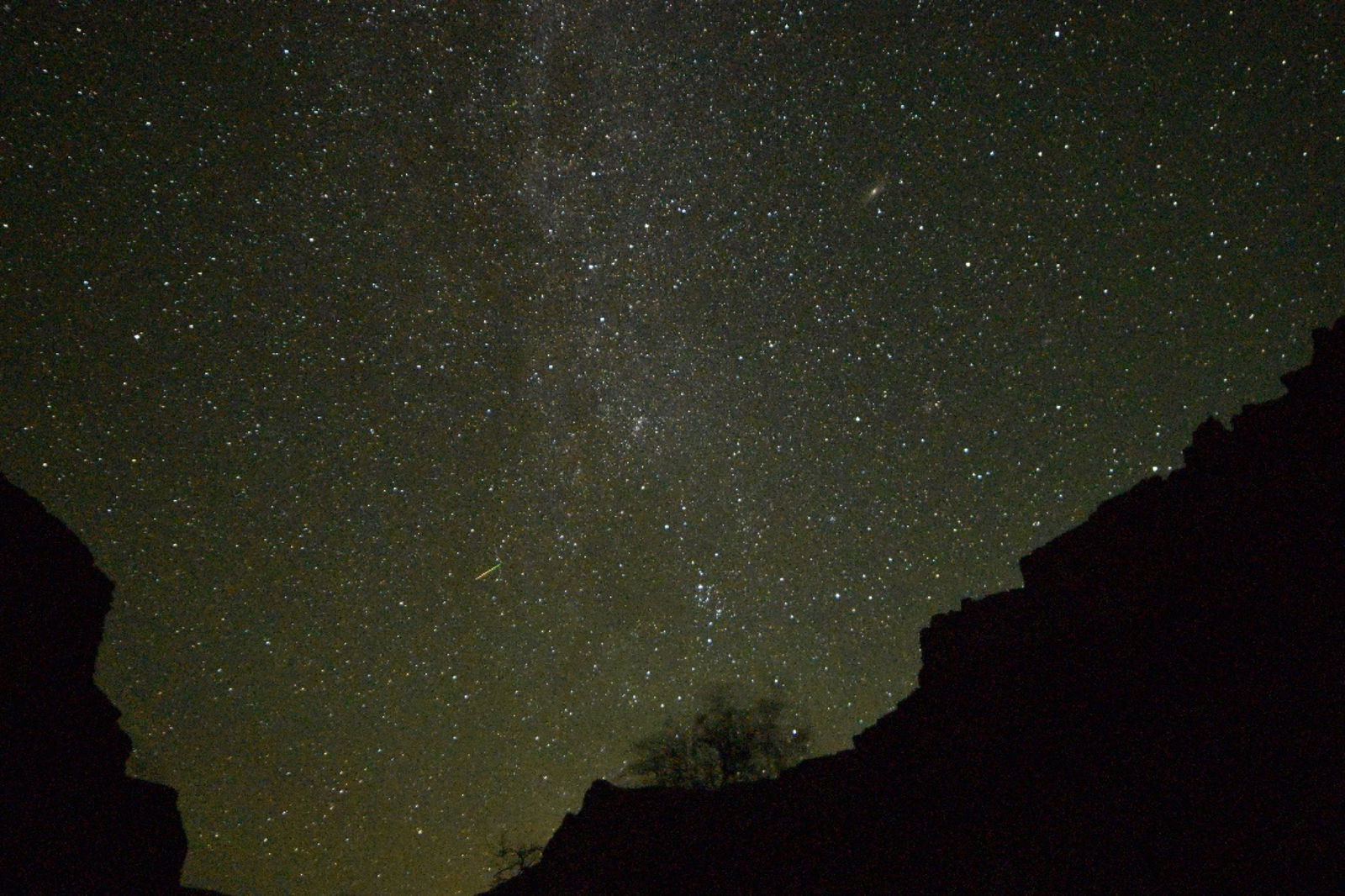
Time-Lapse Videos
The first video is my longest, made from 349 photographs spanning more than four hours. It starts in twilight that quickly fades. It shows the Milky Way skimming the southern horizon as the earth rotates. Unfortunately, there are many airplanes that fly across the view, as well as a few satellites early on. Since I was showing people things in the sky, you will notice my green laser briefly. The red glow that occasionally appears is due to campers walking around with red flashlights. There is a slight bump in the video where I changed the battery partway through.
The little point on the rim of the Canyon directly at the center of the view is the Desert View Watchtower near the east entrance of Grand Canyon National Park. It is 4 ½ miles away. I focused the Questar telescope on the Watchtower before sunset so that our campers could amuse themselves by seeing people walking around on the observation deck next to the Watchtower. As the sky began to darken, I sent pulses from my green laser through the eyepiece of the telescope so that people on the deck could see it. And see it they did. Looking through the telescope, we could see three people waving their flashlights (probably on their cellphones) right away. I continued to send pulses and watch for the reactions from people on the deck. Within minutes, someone began blasting a very bright light source from the deck. It was readily visible with the naked eye. It appeared to be nearly as bright as an automobile headlight. We had no idea what the light was or why someone might carry such a bright light source with them. We exchanged signals for a while, but once the sky got dark enough, I abandoned the effort and began to take photos and do my astronomy program with the people on the raft trip. The person on the rim continued to signal for a while, but he eventually gave up. I blasted a signal several times again at morning twilight, but I received no response.
I made the second video from 247 photographs I took early the next morning. It spans nearly two hours and forty-five minutes. The view is to the northeast, to capture the constellation Perseus, where the radiant of the Perseid meteor shower is located. The north celestial pole, the point around which the stars appear to spin each night, is off to the left of the view. Early in the video you can see the Andromeda Galaxy, though it soon rotates upward and out of the field of view. The Pleiades star cluster rises later, followed by the Hyades cluster. The faint glow that begins to rise toward the end is the zodiacal light. The zodiacal light is sunlight scattered off dust particles in the plane of the earth’s orbit. We are coming up on the time of year when it is best to see the zodiacal light low in the east before morning dawn. I had not seen it well in Grand Canyon before because it is difficult to find a place in the Canyon with a low exposure to the east. We camped at upper Tanner that night, which provides the best view of the sky of any campsite in Grand Canyon.
I made the third video from 102 images I took the first night of our trip. This first campsite has a lovely view looking almost directly south with the Colorado River flowing through the deep notch of Marble Canyon, the upper part of Grand Canyon. I made a similar video last year with the Milky Way spinning through this notch. However, with my old camera, I had to sit at the camera to start each image. Being the first night of the trip, I was exhausted, so there was a limit to how long I could do that. This year, after taking a couple of shots with my new camera, I set up the new camera to take 4,000 photographs and promptly went to sleep (I never get too many stargazers the first night because, like me, they are so tired that first night).
At least I thought it would take 4,000 photographs. When I awoke later, I saw that the camera had stopped. It had taken only 100 photographs. What went wrong? I finally figured it out. I had misunderstood the camera menu. Instead of taking 4,000 images, the camera took a total of 4,000 seconds of exposure. Each photograph took 20 seconds, plus another 20 seconds for a dark exposure for noise reduction. 100 x (20 seconds + 20 seconds) = 4,000 seconds. Since the camera had been idle for quite a while, it did not make much sense to continue taking more photographs of this project because it would leave a large gap in the middle of the time-lapse video. I did take a single photograph, in which the canyon walls frame up the Milky Way quite nicely.
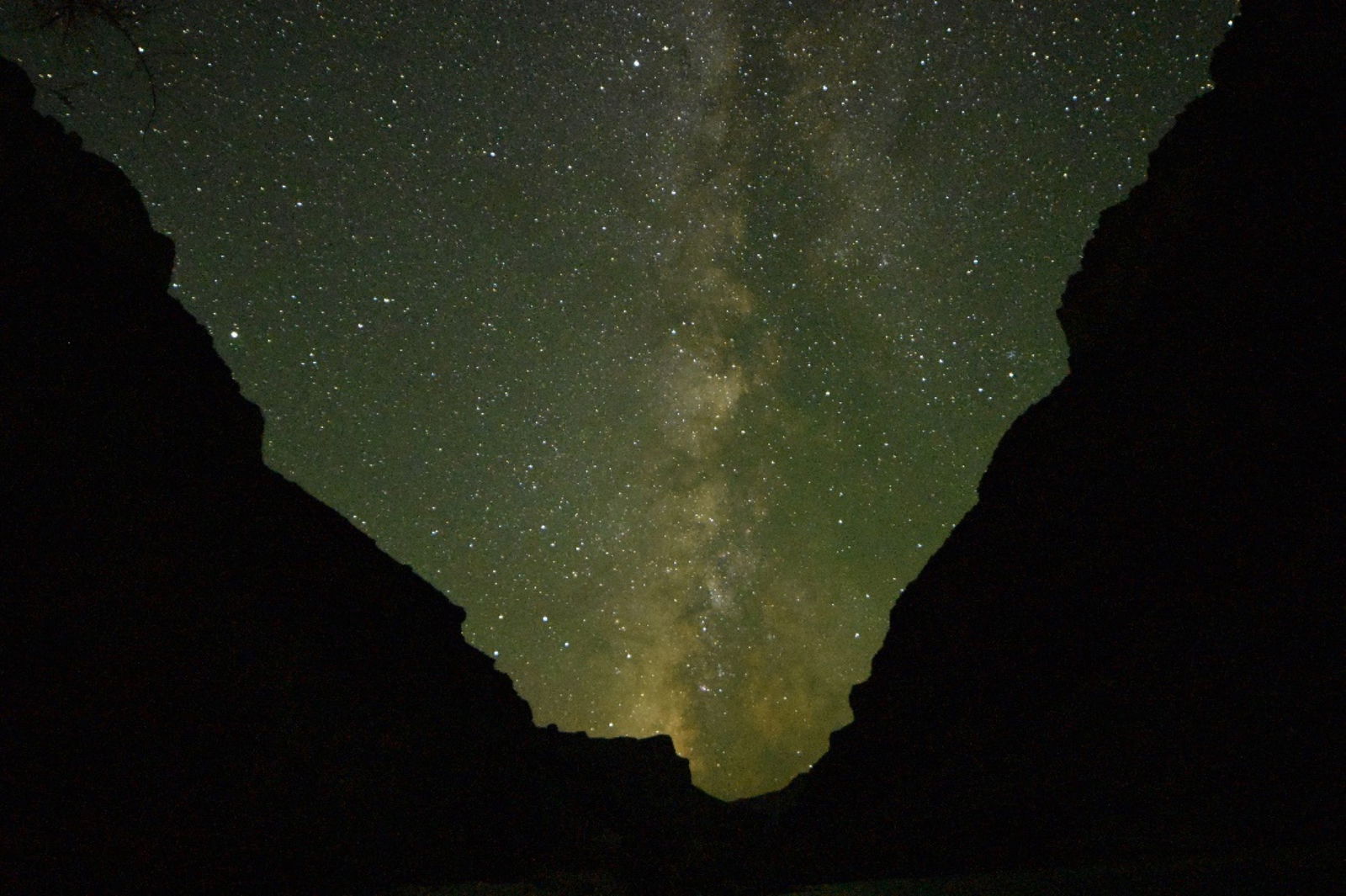
Perhaps next year we can camp at Upper Tanner again so I can get the long time-lapse video of the Milky Way passing through this gap that I missed this year.
Since I had missed out on completing a long video of the Milky Way moving across the sky, I moved the camera to the northeast in hopes of capturing some Perseid meteors, as in the second video here. I made this time-lapse video from 343 photographs spanning nearly four hours. The video continues well into morning twilight.
I was able to photograph on only 2 ½ nights (out of six nights) on this trip. We had too many clouds on other nights, and on one clear night the sky was greatly blocked by smoke from California fires. However, I’m happy with what I was able to do. I have ideas of what to work on during next year’s trip. That trip will be June 20––26, 2022, when the weather is more likely to be cooperative. That trip is already sold out, but there is a waiting list in case someone were to cancel. Also, the following year’s trip is made available to those on the waiting list before it is generally announced. The following year’s trip usually sells out from the waiting list. Therefore, if you wish to join us on these fantastic excursions through Grand Canyon, learning about flood geology by day (and on my trip, astronomy by night), then you ought to plan two years in advance. Why don’t you join us? You can sign up at Canyon Ministries.

Answers in Genesis is an apologetics ministry, dedicated to helping Christians defend their faith and proclaim the good news of Jesus Christ.
- Customer Service 800.778.3390
- Available Monday–Friday | 9 AM–5 PM ET
- © 2026 Answers in Genesis
